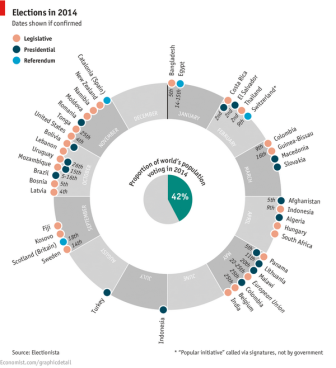Next week, Uruguay’s legislative power will begin to use e-voting. The president of the country’s Chamber of Representatives, Germán Cardoso, announced the parliament’s decision to modernize by means of the installation of 164 microphones (one for every seat) that include an e-voting system. Read about the system’s characteristics here.
Monthly Archives: January 2014
The force of voting will dominate 2014
2014 will experience a true electoral rally. 42 countries are scheduled to carry out elections throughout the year, which means that 42% of the world’s population—barely over 7 billion people—will exert their right to vote.
This huge number of people that will attend polling stations during the next 12 months reflects that voting will be the force dominating 2014, and along with it, technology will assume its role of cornerstone, by facilitating and optimizing the complex stages comprising an electoral event.
Among the busy electoral calendar this year, we can count 16 presidential elections—26 legislative ones, two regional electoral events, and four referenda. Some will be conducted simultaneously in five countries, four of them from Latin America: Costa Rica (February), Panama (May), Uruguay (October), and Bolivia (October). These nations will choose their new president and renew their parliaments.
In spite of the significance of these processes, these four countries are not the only ones in Latin America to hold electoral events, as El Salvador (February), Ecuador (February), Colombia (March and May), Peru (October), and Brazil (October) are getting ready to strengthen Democracy with the election of a new president, and in Colombia’s case, they will also vote to choose their legislators, while Peruvians will elect regional and local authorities.
The electoral rounds in Latin America represent a great opportunity for testing electoral technology, due to the fact that just as Brazil confirms its status of e-voting giant—it began automating elections since 1996—, nations such as Colombia and Ecuador will conduct various pilot tests in order to determine the automated model that adapts to their needs, and Peru will once again use their locally designed system to modernize suffrage.
Other countries worth highlighting from among those celebrating elections this year are Belgium and India. The first one decided in 2012 to resume e-voting with the help of the multinational Smartmatic, while the second will use voting machines once again this year. India implemented the use of voting machines between 1998 and 2004. Moreover, the US will put more than 3,000 technologic solutions to the test during its elections throughout its 50 states.
The 2014 electoral agenda will be particularly intense, and e-voting will have a golden opportunity to keep astonishing the world with its effectiveness, but above all, it will be able to strengthen its capability to be the safest, fastest, and most transparent tool to preserve the people’s intent.
Ecuador continues e-voting training
In light of the upcoming February elections, where a binding e-voting pilot will be conducted, Ecuador is continuing with the voter and technician training processes. Even in the remotest areas of the selected districts in which the pilot will take place, there have been training sessions using the voting machines in order for voters to become familiar with the equipment. Find more information here.

